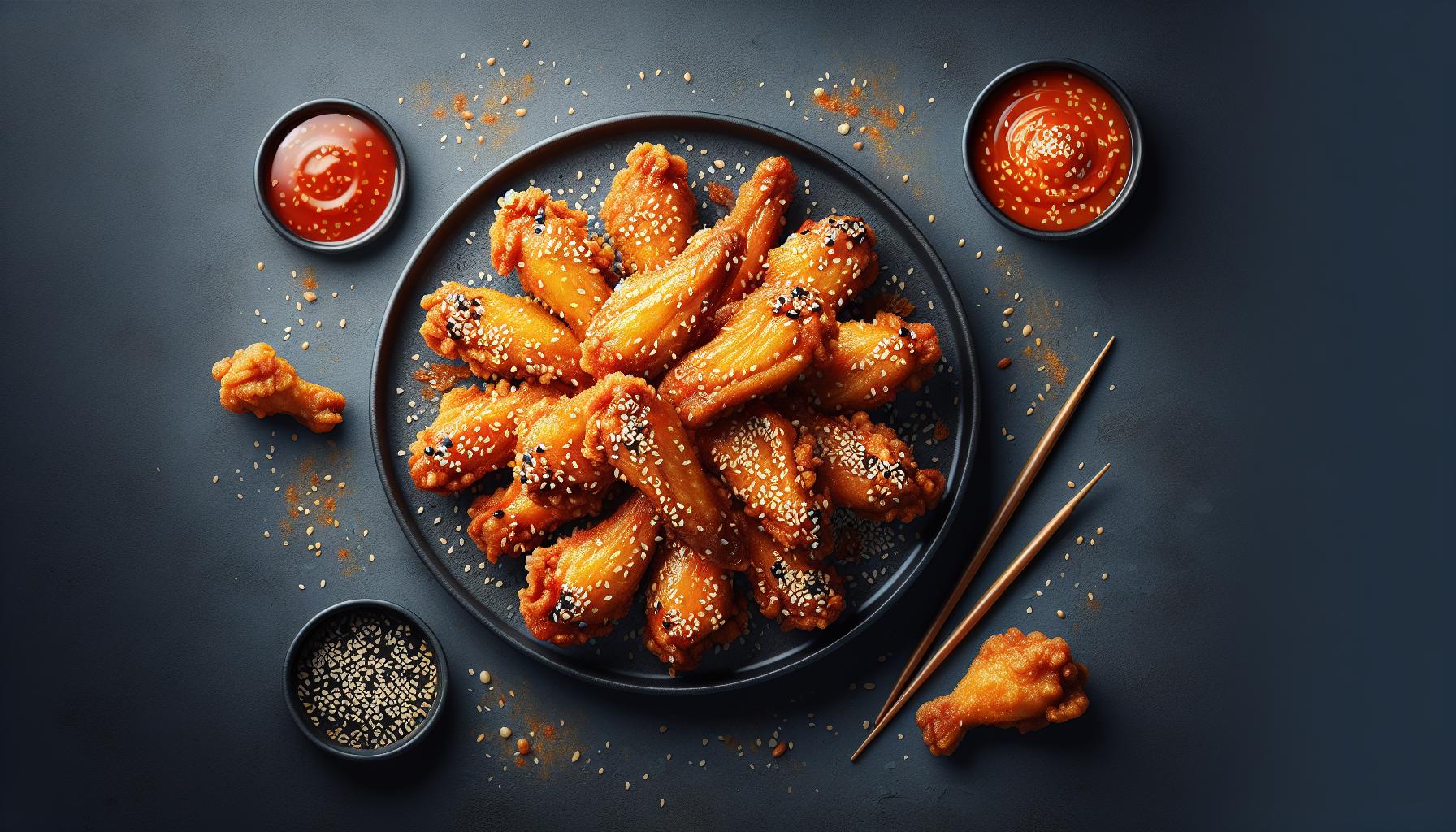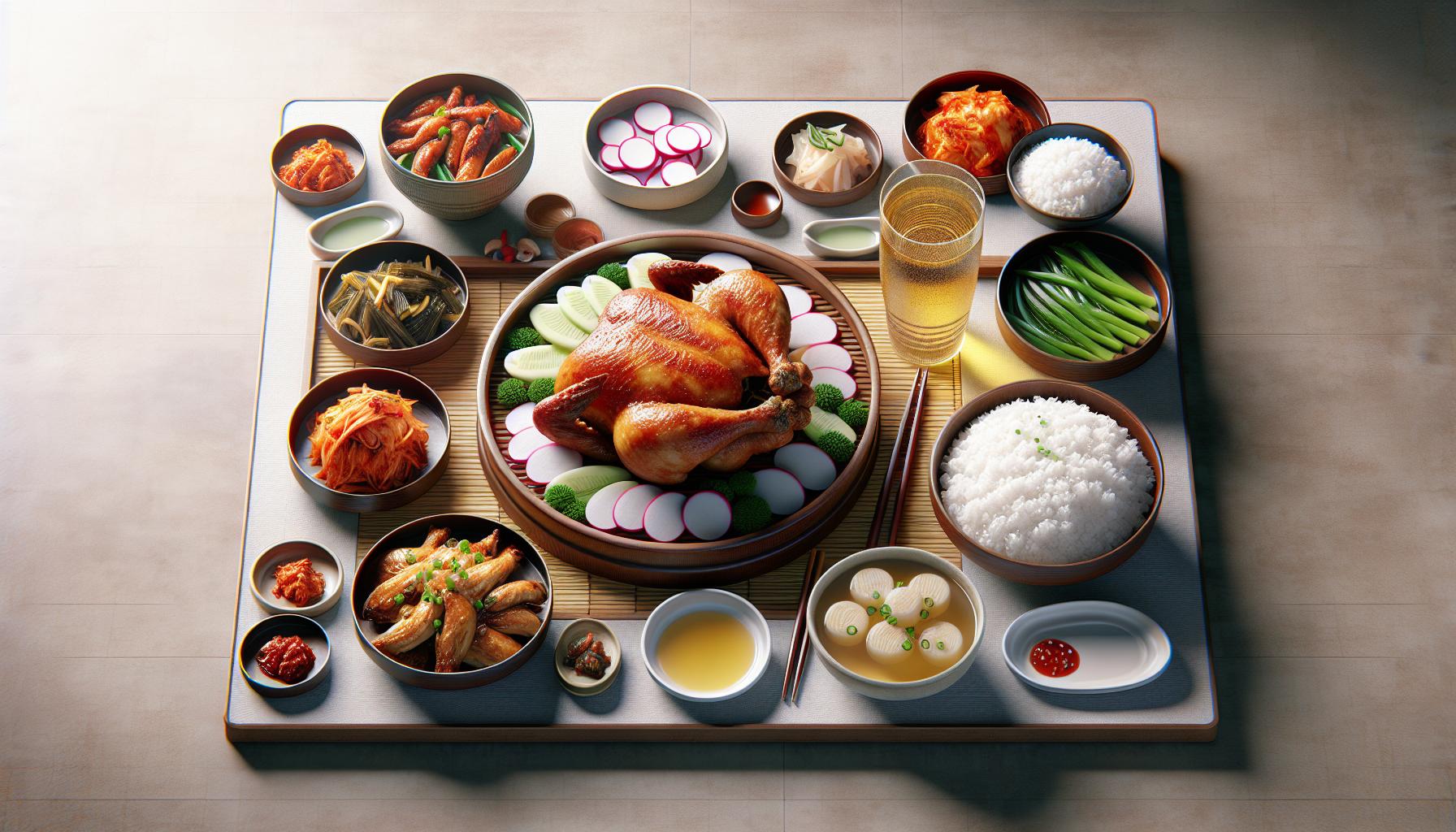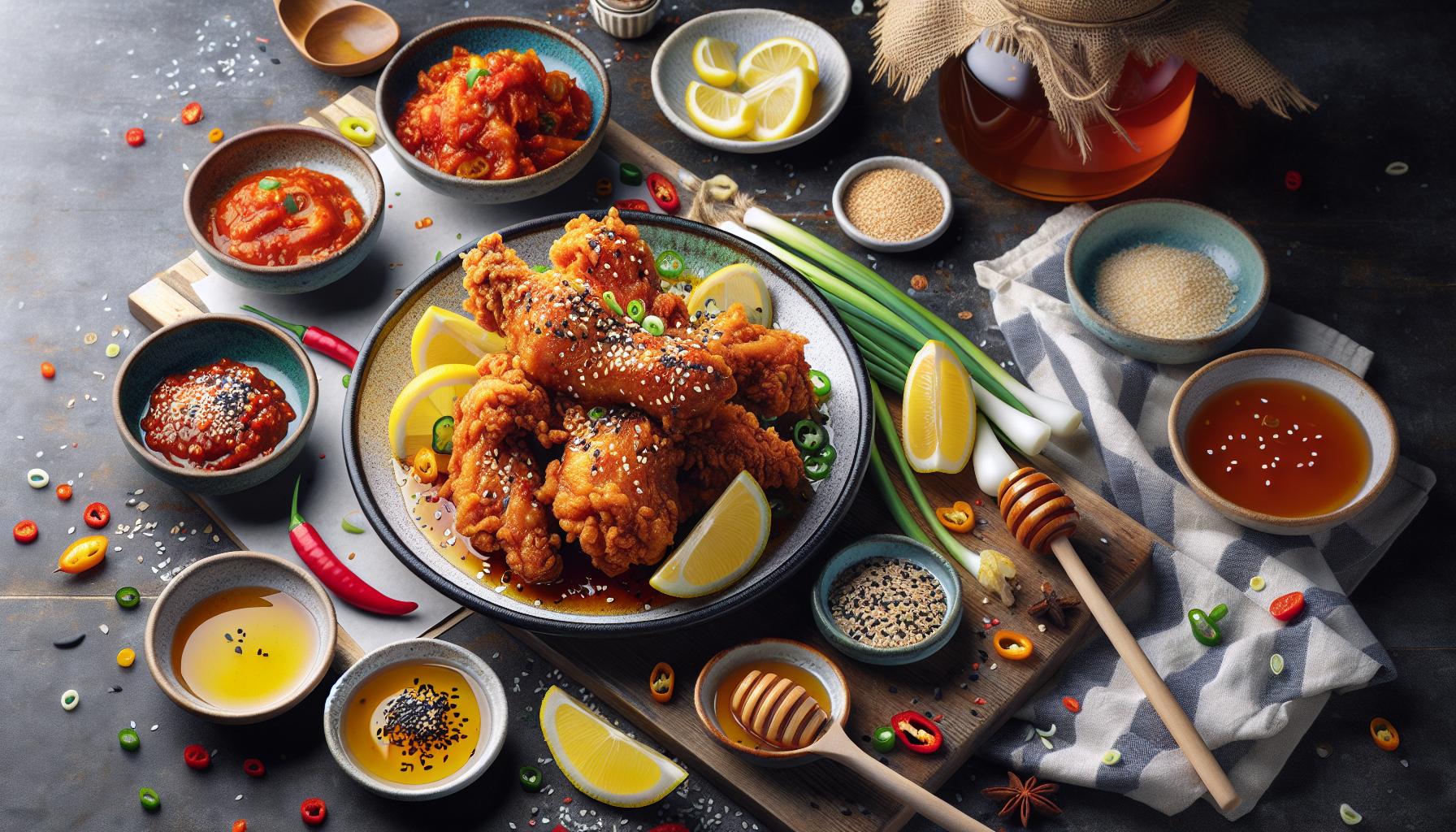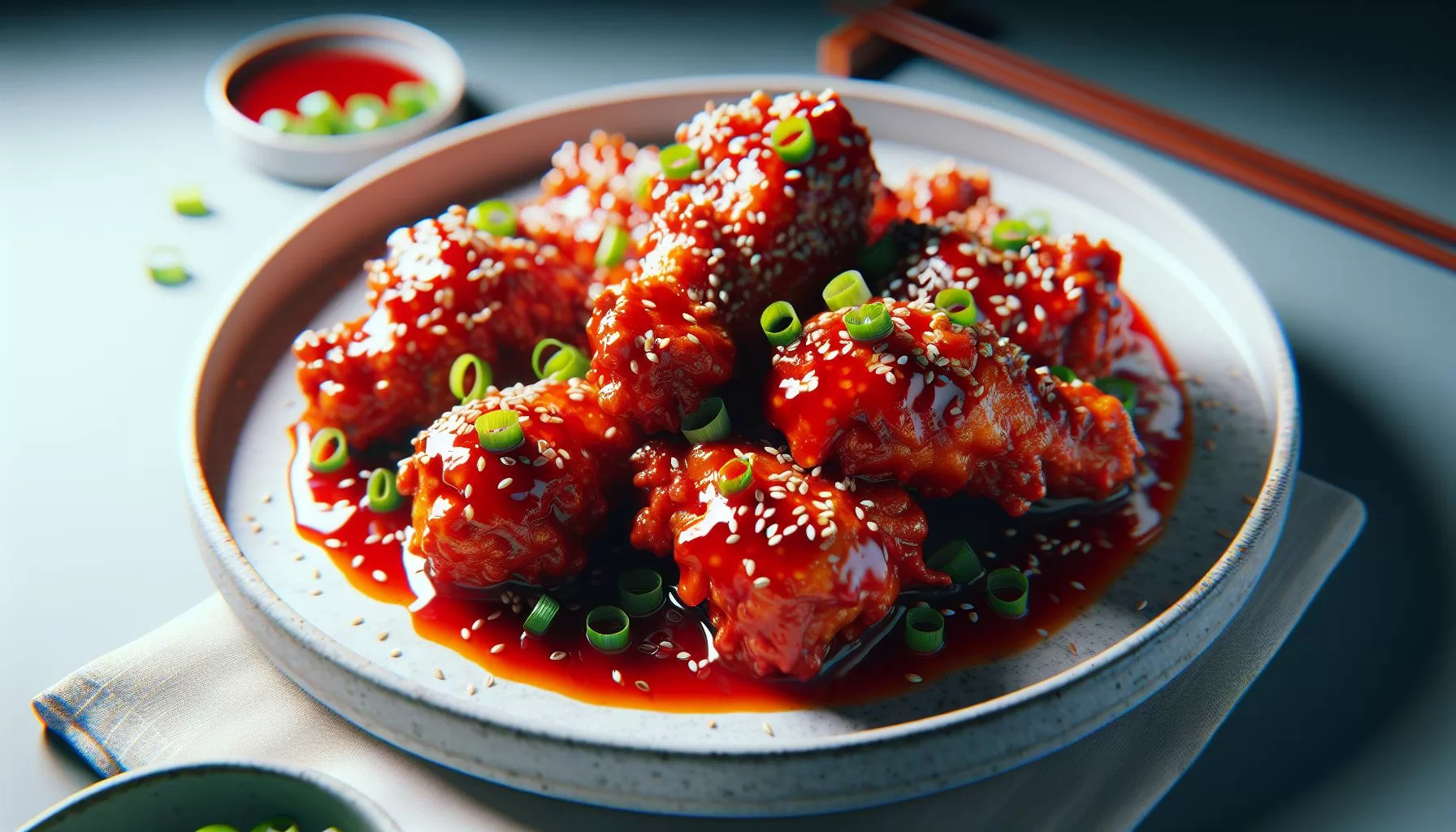Ingredients for Homemade Yangnyeom Chicken
Ready to spice up your kitchen? Here’s what you’ll need!
The star of our recipe, naturally, is the chicken. You’ll need about 1 kg of chicken wings but you’re free to substitute with boneless chicken cubes if preferred. Aim to surprise your tastebuds!
Let’s move on to the batter! Your magic concoction involves 150 grams of flour, 50 grams of cornstarch, an egg, and a pinch of salt & pepper. The secret is in the mix: blending flour and cornstarch creates a crispy-licious texture that holds up even when drenched in sauce.
And about that fiery sauce that yangnyeom is famous for. You’ll require the following:
- 6 tablespoons of ketchup – it’s the base, giving that tangy sweetness
- 3 tablespoons of gochujang – the unique Korean chili paste that delivers an unforgettable kick
- 2 tablespoons of soy sauce – providing that savory flavor balance
- 2 tablespoons of honey – to compliment the spice with some sweetness
- 2 cloves of garlic, minced – because garlic fuses it all together
Keep in mind, gochujang is what makes the sauce authentically Korean. However, spice tolerance varies so don’t hesitate to adjust the heat level according to your palate.
Now, remember you’re creating a masterpiece! You can bend traditions, add twists and tweaks. Get adventurous and maybe add a hint of ginger for an extra zing or sprinkle sesame seeds for added crunch.
For a quick peek, check out the table below:
| Ingredient | Amount |
|---|---|
| Chicken wings | 1 kg |
| Flour | 150 grams |
| Cornstarch | 50 grams |
| Egg | 1 |
| Salt & Pepper | Pinch |
| Ketchup | 6 tablespoons |
| Gochujang | 3 tablespoons |
| Soy sauce | 2 tablespoons |
| Honey | 2 tablespoons |
| Garlic, minced | 2 cloves |
Step-by-Step Instructions

Follow these simple steps carefully to create your delicious Homemade Yangnyeom Chicken.
Prep the Chicken
To begin with, clean your chicken wings properly. For food-safety reasons, be aware of cross-contamination. Use fresh paper towels to dry the wings. This step’s your key to a crispier fried chicken.
Batter up!
In a large bowl, mix the crispy batter ingredients. Make sure it’s not lumpy. Dip each chicken wing into the mix, ensuring it’s fully coated. Set aside for about 15 minutes. This wait time allows the batter to adhere to the chicken – another trick for extra crunch.
Fry-it-up
In a deep frying pan, heat the oil. The perfect temperature you’re looking for is around 350°F (175°C). Watch out, you don’t want the oil too hot or too cold. Once ready, fry the wings until they’re golden brown. It’ll take approximately 10 minutes.
**Sauce **
Here’s where the fiery sauce comes into play. In a saucepan, combine the Ketchup, Gochujang, soy sauce, honey, and garlic. You can adjust the spice level to fit your preference. Add ginger if you’re feeling adventurous or sprinkle in sesame seeds for an authentic Korean touch. Bear in mind the sauce should simmer, not boil. You want the flavors to mingle, but you don’t want them to lose their punch.
Dip’n’Dazzle
Dip the fried wings into the sauce or drizzle the sauce over them. Work fast, you want the wings to still be hot to soak up all that lovely sauce.
Remember, Homemade Yangnyeom Chicken is all about your individual taste. Yes, there’s a traditional recipe but feel free to make it your own. Experiment with different spices or even citrus zest. You never know, you might come up with a whole new version that’s unique to your kitchen.
And who said delicious can’t be healthy? Let’s take a closer look at what you’re feasting on:
| Nutrients | Amount per Serving |
|---|---|
| Calories | 200 |
| Carbs | 24g |
| Protein | 15g |
| Fat |
Tips for the Perfect Korean Fried Chicken

We’re in the thick of it now so draw on your inner chef because these tips could make all the difference in your Homemade Yangnyeom Chicken. Let’s dive into unlocking that crispy, spicy perfection.
First and foremost: Be vigorous in drying your chicken wings. Sounds a bit dramatic, right? Well, it’s not. The drier the chicken, the crispier the final result. So leave no moisture behind! Use a towel, leverage some air drying time, and ensure each piece is dry to the touch.
Next up: Take your time with the frying process. Now, this doesn’t mean you have to watch each wing like a hawk. However, avoid overcrowding the pan. Give each piece its breathing space to ensure an evenly golden-brown color. Remember, patience is key.
And on the topic of frying: Don’t shy away from double frying. It might seem like uncharted territory. Still, double frying these wings can enhance the desired crunch. It’s worth the extra step, so take the plunge.
When it comes to the sauce, Personalize your spice level. Though the standard recipe demands a fiery kick, you’ve got the steering wheel. Make adjustments to the quantity of Gochujang or even try adding a twist with some ginger or citrus zest.
Keep the following nutritional table handy. It can help you make informed decisions about portion sizes, and it’s always interesting to know what’s going into your body.
| Nutrient | Amount per serving |
|---|---|
| Calorie | !TBD! |
| Carb | !TBD! |
| Protein | !TBD! |
| Fat | !TBD! |
Finally, a personal favorite tip of mine: Sesame seeds aren’t just for garnishing. With their nutty flavor and crunch, they can add a whole new dimension to your dish. Sprinkle them in your sauce or toss them in at the end. They can transform your Chicken into a gourmet delight.
Serving Suggestions and Pairings

Now that you’ve got your homemade Yangnyeom Chicken ready, it’s time to think about the ideal accompaniments for this crunchy delight. These add-ons aren’t just about building a well-rounded meal, but they can also accentuate the flavors of your Korean fried chicken.
To start with, pickled radish serves as a wonderfully refreshing counterpoint to the spicy Yangnyeom chicken. Its juicy, mildly sweet, and tart flavor does wonders to cleanse the palate.
If you’re in the mood for something warm and comforting, think about serving up a bowl of Korean Steamed Rice. Its delicate flavor and sticky texture make it an excellent base, allowing your chicken’s vibrant tastes to truly shine.
Of course, let’s not forget about kimchi. This spicy, fermented cabbage is a staple in Korean cuisine and your palate will love its contrasting flavor. Trust us, once you try these together, you’ll always want them by your side.
For an authentic Korean dining experience, serve your Yangnyeom chicken with a small bowl of Doenjang Jjigae. This rich soybean paste stew has a deep, complex flavor profile that’ll complement your chicken wonderfully.
| Pairing | Description |
|---|---|
| Pickled radish | Juicy, mildly sweet and tart, excellent palate cleanser |
| Korean steamed rice | Mild flavored and sticky, good as a base |
| Kimchi | Spicy, fermented cabbage, adds contrast |
| Doenjang Jjigae | Rich, soybean paste stew, colorfully complements |
As for drinks, Korean Soju is a classic pairing with Korean fried chicken. For a non-alcoholic option, Korean barley tea or Sikhye, a sweet rice beverage, is perfect.
Indeed, the possibilities are almost endless when it comes to pairing your homemade Yangnyeom chicken. Feel free to play around and discover your own unique combinations!
Last but not least – don’t forget the presentation. Using some lettuce leaves to scoop up your chicken or serving your meal on traditional Korean cookware can add that extra touch. After all, good eating isn’t just about the taste – it’s a sensory experience of sight, sound, and aroma as well.
Variations and Customizations

Ready for a delightful tweak to your Homemade Yangnyeom Chicken experience? You’re all for it, right? Let’s scratch that itch for creativity and experimentation in culinary arts. It’s time to put your own twist on this classic Korean fried chicken recipe.
Ingredient Swaps
You might be thinking, where’s the room for personal touches in a well-defined recipe? Trust us, there’s plenty. You can go bold with the sauces. Tired of the classic sweet-spicy flavor? How about using Gochujang or Ganjang? They’re Korean staples adding a punch of heat and flavor.
If your palate leans towards something less spicy, switch to a salivating honey-lemon glaze. The tanginess of the lemon beautifully contrasts the deep-fried chicken while honey lends its silky, sweet kiss. Remember, don’t shy away from customizing based on your taste buds.
Explore Different Cooking Techniques
Hankering for something less greasy? Air frying can be a great alternative to traditional frying. It offers a healthier version without compromising much on the crispiness or flavor. The result is a lower fat, less greasy rendition of your favorite Korean chicken.
You can also try baking the chicken for a roast-like finish. It requires a bit more patience, but the outcome can often be worth it.
Garnishing for Extra Punch
Why stop with main ingredients when garnishes can add a final flourish? Sprinkling some sesame seeds or chopped spring onions enhances both the aesthetics and flavors. Even cheese can be an exciting addition, especially for those who enjoy creamy, savory notes.
So there you have it. A few twists and turns can spice up your homemade Yangnyeom Chicken, making it uniquely yours. It all boils down to your preferences and creativity. After all, experimenting is half the fun in cooking, isn’t it?
Conclusion
So there you have it! Your guide to whipping up a delicious batch of homemade Yangnyeom Chicken. Remember, the beauty of this Korean fried chicken recipe is in its flexibility. Don’t shy away from swapping Gochujang with Ganjang or trying a honey-lemon glaze. You’re in control of the flavor profile. If health is your concern, consider air frying or baking instead. And let’s not forget those garnishes. Sesame seeds, spring onions, or cheese can add that extra oomph. It’s all about making it your own. After all, cooking should be about enjoyment and experimentation as much as it is about following recipes. Now, go forth and create your version of this Korean classic!

